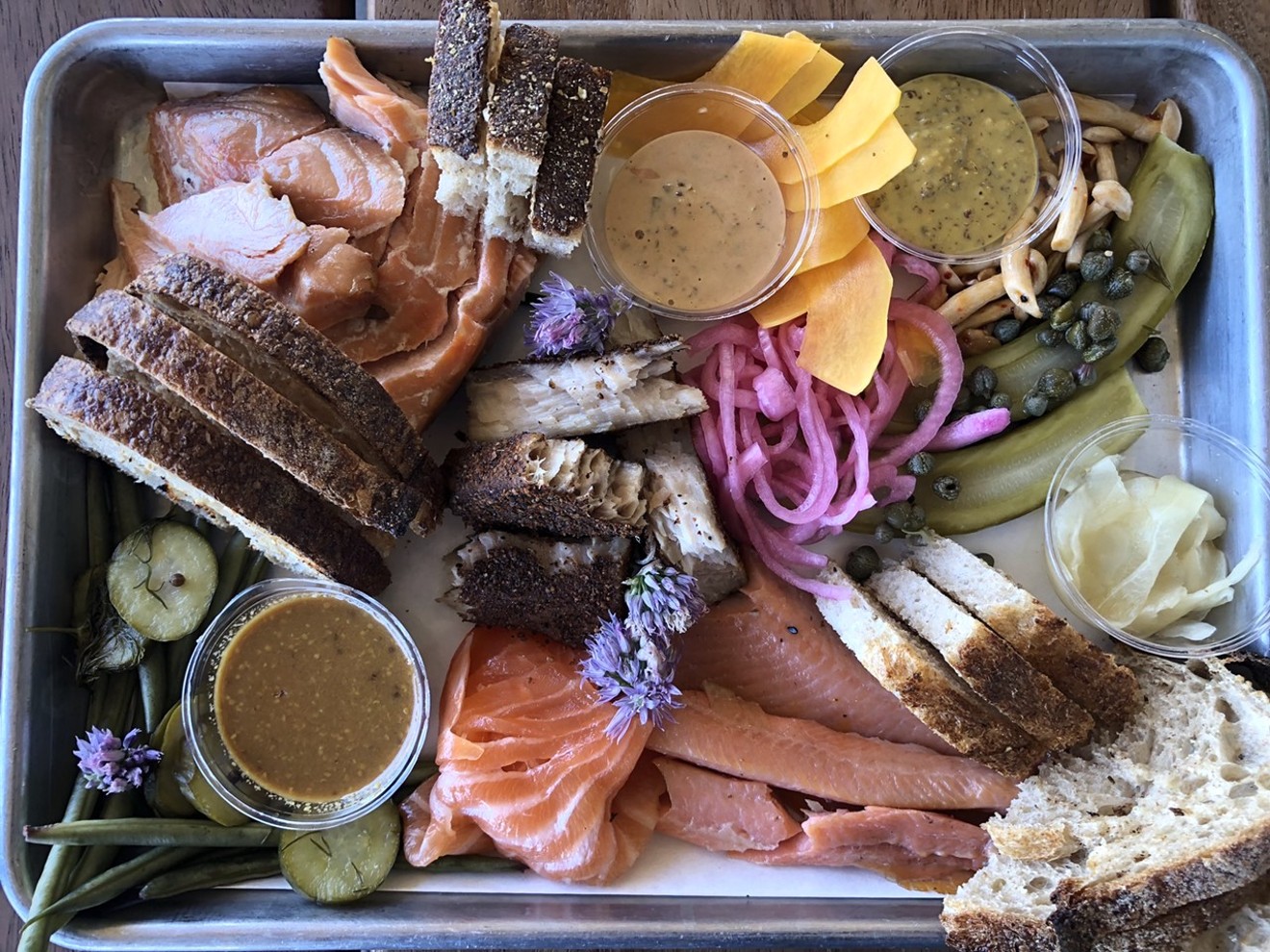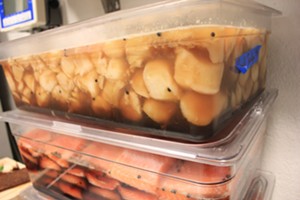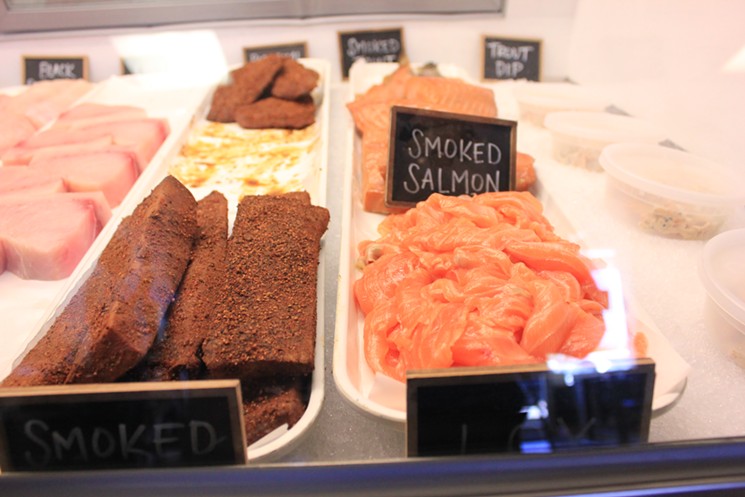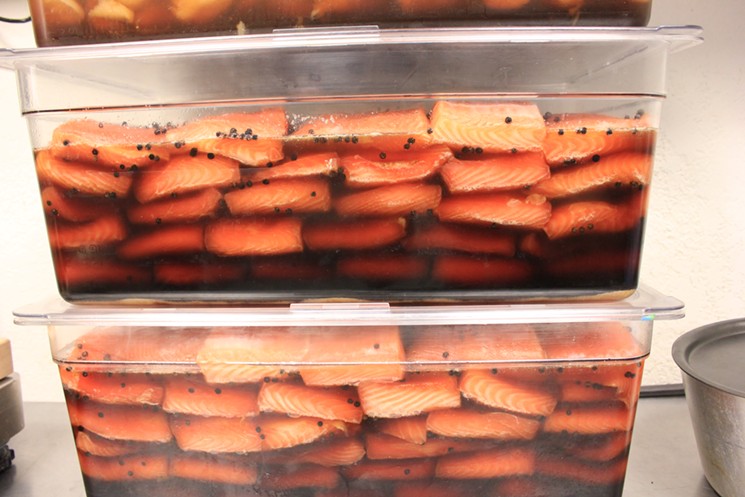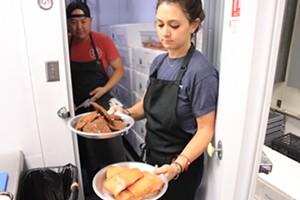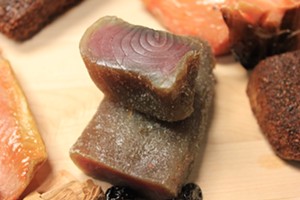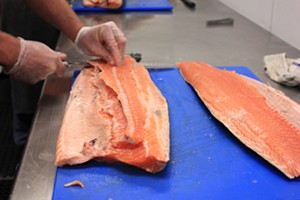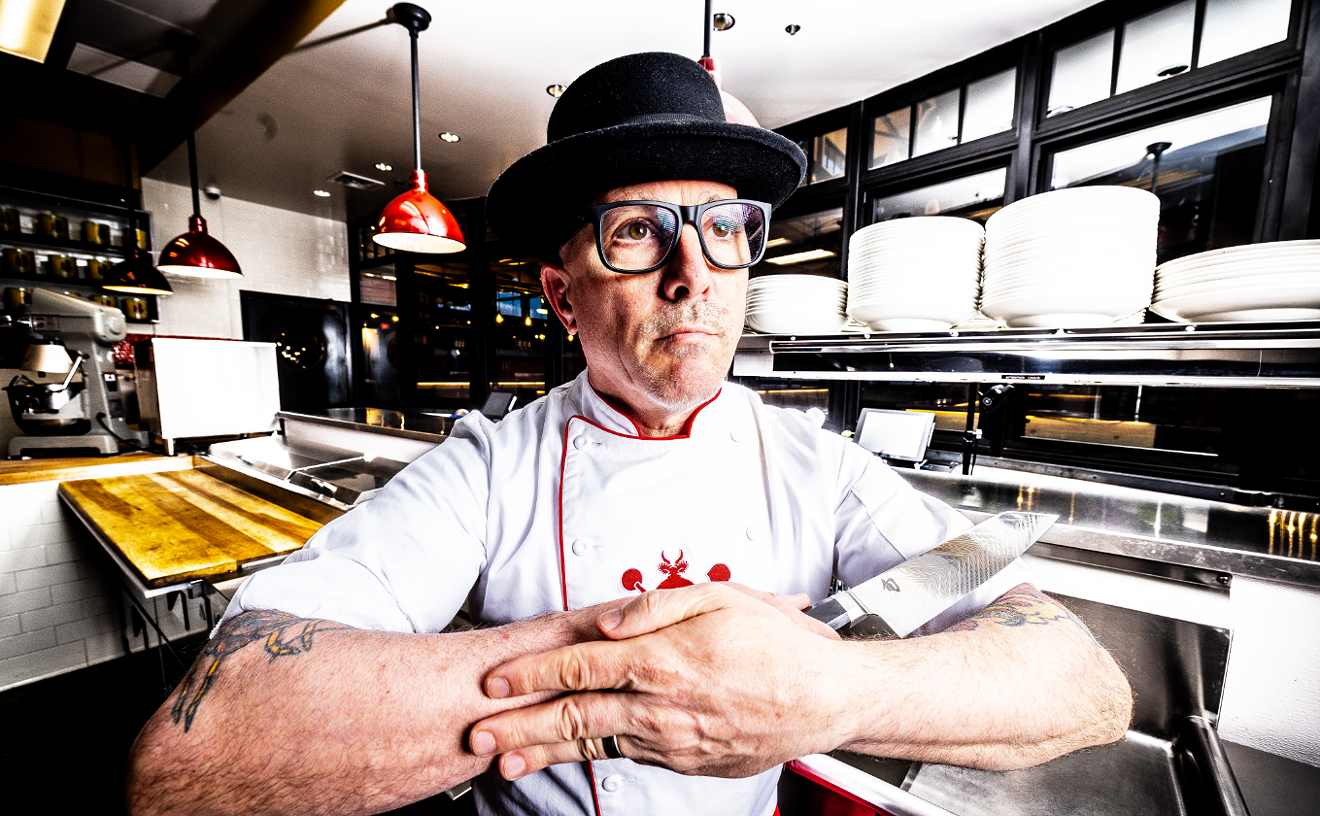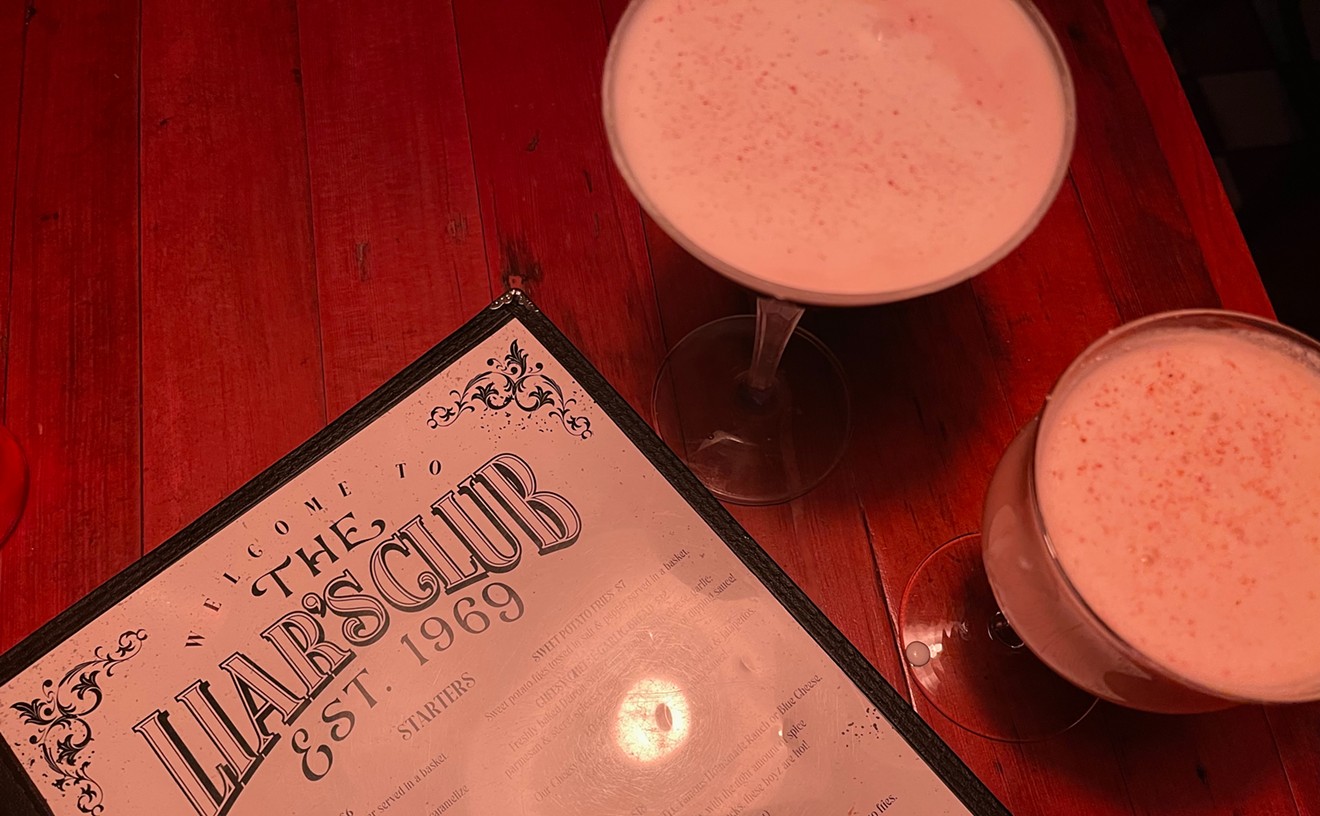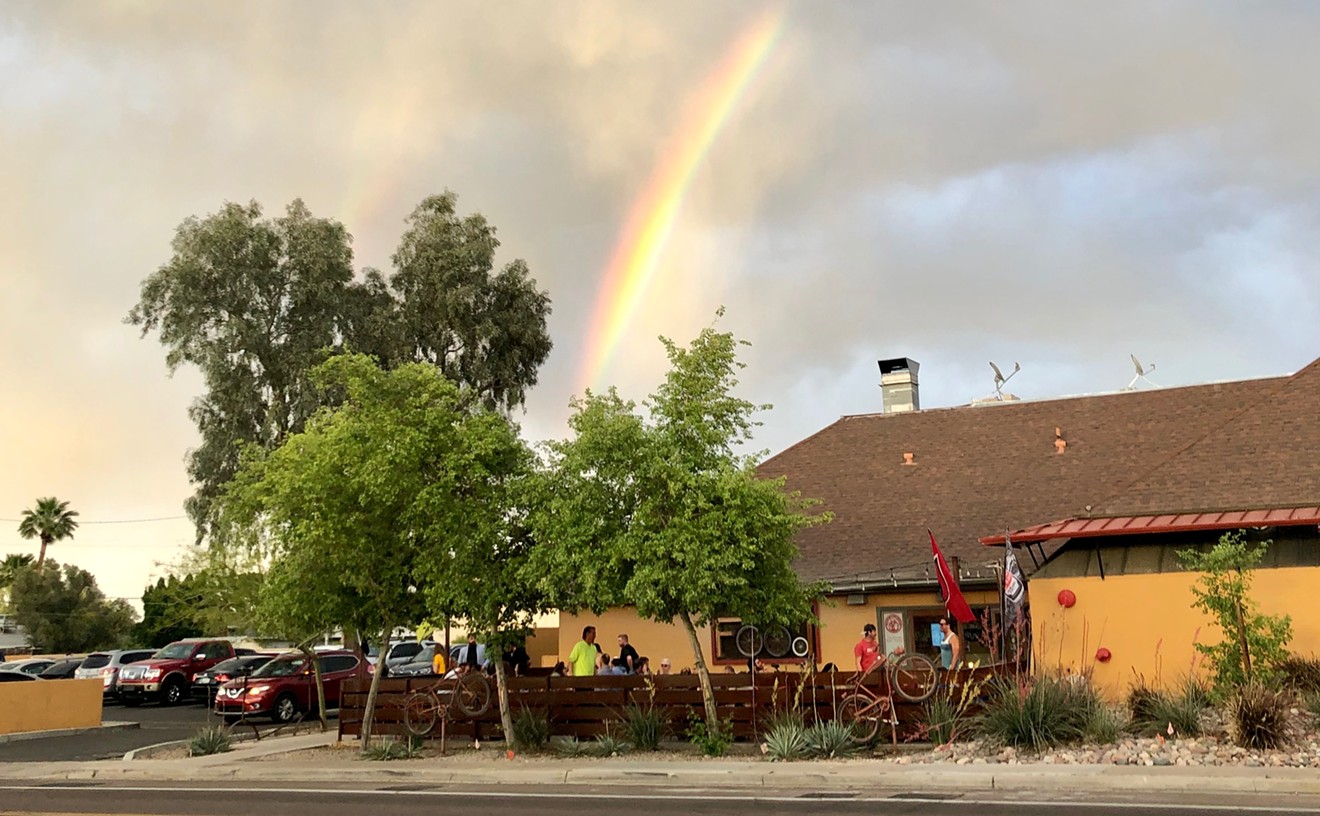Welcome to Smoke Rings, a series about the Valley of the Sun's barbecue scene. The goal of this series is to pin down a "Phoenix-style" barbecue if there is one. Regardless of whether we have a style, a barbecue boom has taken the Valley this decade. Here, we outline the 'cue scene in ash and sauce and gnawed ribs. So bring your appetite, curiosity, and open mind as we chomp our way to answers.
Necessity is the mother of all barbecue. Here, we’re not talking about grilling, or about global barbecue, but barbecue the made-in-America cuisine — the cuisine of brisket and pulled pork. Barbecue was started by poor folks who needed to turn tough cuts and throwaway pieces into dinner. Hours of smoke tenderize even brisket, one of the cow’s most leathery cuts.
Chula Seafood in Scottsdale started smoking fish for related reasons. “Initially," chef Juan Zamora says. “We started smoking to utilize the byproducts: the end pieces, the tail pieces, all the little bellies that aren’t really used in wholesale or any other place. It was kind of a case of just preservation of the product.”
The need to tenderize off cuts. The desire not to waste. The genesis of Chula Seafood’s now-robust and growing smoked fish program is similar to that of American barbecue.
At first, Chula was smoking finfish odds and ends. Now, Chula smokes 120 pounds of salmon a week — and that's just salmon.
Chula also smokes scallops. Chula smokes trout. Chula smokes black cod from off a friend’s boat in San Diego, sometimes with miso. Chula smokes salmon, lox-style, pastrami-style, and standard.
Chula smokes the bellies of swordfish caught by harpoon or drop set buoy. “The belly is the best piece to smoke, because it has the most amount of fat,” says Jon Heflin, co-owner of Chula. Sometimes, Chula even smokes swordfish bellies pastrami-style, meaning cured, left for an hour in spices to dry and pick up a coarse coat, and smoked over cherry wood.
Like the black cod, swordfish are caught in San Diego. They are caught on Chula’s boat, a 50-footer piloted by Heflin’s father, one of the co-owners. The third co-owner is Hogan Jamison. Together, Heflin and Jamison helm the Scottsdale location of Chula Seafood, driving fish in from San Diego two or three times a week. Chula sells wholesale to restaurants, and prepared foods (bowls, sandwiches, platters) and fish to go to regular people who crave gem-like red tuna, light pink swordfish, and fat white scallops.
The rightmost rows in Chula's display case show smoked fish. You can snag this fish for the road, or you can snag a dish incorporating this fish, like a salmon pastrami sandwich, for now.
Smoking fish is different from smoking meat. The muscular structure is sparser, the cuts generally smaller, the flesh more delicate. Zamora has found that many common barbecue woods, such as pecan and apple, are too potent to be used for fish.
“We use cherry wood," Zamora says. “It creates a nice sheen, a richer honey-brown.” He also notes that cherry wood provides a better smoke for the more subdued flavors of seafood.
Smoking fish diverges from barbecue in another way, the hugest way imaginable: Smoking ain’t even the most vital alchemy in the process.
“The curing process is the most important part,” Heflin says.
Chula cures fish (prior to smoking) using sugar, salt, and black pepper. “That creates solubility,” Zamora says, “which extracts the water, proteins, and fats from the muscular fish itself … it essentially ends up in a brine, but starts as just a rub.”
This is how the cure works: Sugar, salt, and black pepper go on the fish. The fish’s liquors and other essences are drawn out, pooling containers with liquid. The fish changes over time. Scallops get a day and a half (more delicate) and salmon gets up to four days (more aggressive).
After the cure, rubs of varying intensities are caked on.
And finally, we’re ready to smoke the good stuff.
Zamora and the Chula crew smoke using two upright smokers with four trays per. The smokers use electricity, wood chips, and are temperature-controlled.
Unless Chula starts sourcing some kind of huge sea creature, you won’t see anything smoked nearly as long as pork butt or brisket’s half day or longer. At Chula, scallops smoke for 30 minutes at about 230 degrees. Salmon goes for just over an hour at about 200, maybe a little hotter. The longest-smoked food, actually, is a pineapple.
Pineapples get brined in a sugar-soy mixture and smoked, lacquering their exteriors with caramelization. Pieces go into Chula’s salmon bowl, bringing smoky and roasted flavors to jigsaw into the salmon’s flavor profile.
Chula reaches peak Chula-ness with its mojama.
Mojama is a cured yellowfin tuna, a Spanish delicacy. To make mojama, Zamora cures tuna for three months. He then air-dries the fish for three to four weeks depending on the tuna’s size. The purple-black lump that results looks like a living rock from Neptune, but, grated over food as you would grate Parmesan (or bottarga), mercurial flavors can be added.
The start-to-finish care that goes into smoked fish products like mojama has made Chula huge to local restaurants. The roster of chefs who use Chula smoked fish includes Chris Bianco and Cassie Shortino (Tratto), Charleen Badman (FnB), Chrysa Robertson (Rancho Pinot), and others.
The best way to get your tongue on Chula’s smoked fish is with a sampler platter. At $24, it isn’t cheap, but if you roll up in the late afternoon with a friend and some craft beer or wine, you’re going to have a heady gastronomic experience.
On the tray you will find, in pink folds and green curves and yellow pools, in some variation based on what's in, Noble Bread, pickled ginger, pickled enoki mushrooms, capers (not pickled in house), Steve’s Wonder Mustard, house-made thousand island dressing (great with pastrami-style smoked fish), miso dressing with a spice that might surge up your nostrils, pickled onion, pickle butternut squash, pickled string beans, and five or so kinds of smoked fish. What kinds? It changes.
The delicate world of beautiful flavors that smoke can engender is hypnotic, and so are the textures. They are sharpened and remixed and whipsawed by the platter's other elements.
What makes Chula's smoked fish so good, too, is sourcing. Some fish comes from San Diego. Some comes from afar. Nothing comes with antibiotics or GMOs. Salmon comes from the Pacific waters in season, mostly from the Faroe Islands out of season. What ends in your mouth as the gustatory equivalent of a finely curled 10-foot wave of green ocean water started in that water, well below the surface.
Chula's start-to-finish fish smoking can hang with some of the better barbecue-style smoking being done in metro Phoenix. Every step respects and channels the sea.
Fish-Smoking Joint(s): Chula Seafood
Smoke Masters: Juan Zamora, Jon Heflin, Hogan Jamison
Wood: Cherry
Notable Specials: Salmon pastrami sandwich (Thursday), lox on a New Wave Market bagel (Saturday), and once-in-a-blue-moon specials like miso-smoked black cod (typically a Friday special).
Special Something: The liquid leftover from curing fish becomes, thanks to cooking and doctoring with garlic, yuzu, vinegar, and other ingredients, Chula's house sweet-and-sour sauce.
Quirk: Chula will be opening a new location later this year. Heflin says the crew is really just getting its fish smoking program started. Plans are shaping up for wider distribution, tuna blood sausage, and more.
Contact/Hours: 8015 East Roosevelt Road, Scottsdale; 480-621-5121.
Tuesday to Saturday 10 a.m. to 7 p.m.
[
{
"name": "Air - MediumRectangle - Inline Content - Mobile Display Size",
"component": "18478561",
"insertPoint": "2",
"requiredCountToDisplay": "2"
},{
"name": "Editor Picks",
"component": "16759093",
"insertPoint": "4",
"requiredCountToDisplay": "1"
},{
"name": "Inline Links",
"component": "17980324",
"insertPoint": "8th",
"startingPoint": 8,
"requiredCountToDisplay": "7",
"maxInsertions": 25
},{
"name": "Air - MediumRectangle - Combo - Inline Content",
"component": "16759092",
"insertPoint": "8th",
"startingPoint": 8,
"requiredCountToDisplay": "7",
"maxInsertions": 25
},{
"name": "Inline Links",
"component": "17980324",
"insertPoint": "8th",
"startingPoint": 12,
"requiredCountToDisplay": "11",
"maxInsertions": 24
},{
"name": "Air - Leaderboard Tower - Combo - Inline Content",
"component": "16759094",
"insertPoint": "8th",
"startingPoint": 12,
"requiredCountToDisplay": "11",
"maxInsertions": 24
}
]

